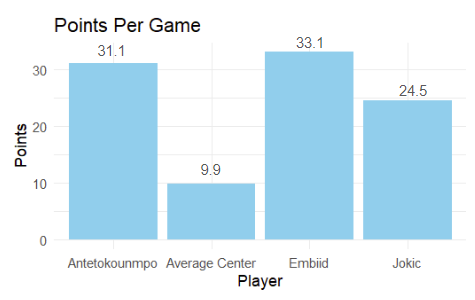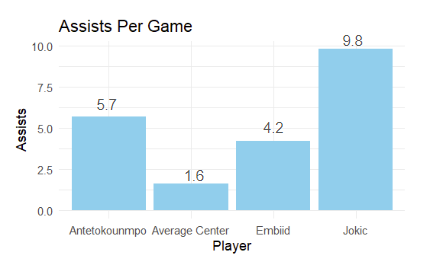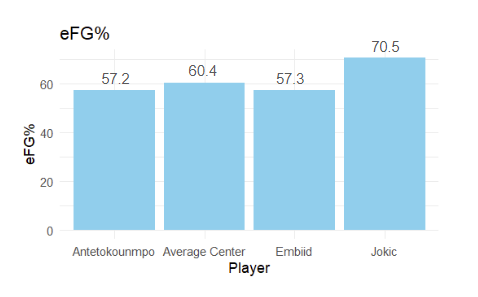How does Nikola Jokic power the Nuggets’ Elite Offense?
- Bruin Sports Analytics

- Mar 27, 2024
- 7 min read
By: Stanley Hsu and Joshua Sujo
Introduction:
Nikola Jokic is the star player of the Denver Nuggets, the most recent NBA Champions. He is arguably the best player in the league, having won the Most Valuable Player award in two of the past three years. In this article, we use Jokic’s stats from the 2022-2023 season, as well as stats from his Nuggets teammates throughout the season. In that season, the Nuggets coasted to the best record in the Western Conference and won the franchise’s first-ever championship.
Part 1: Jokic’s MVP-Level Stats
To give some perspective on how good Nikola Jokic is, we will compare his stats with 2023 MVP Joel Embiid, two-time MVP Giannis Antetokounmpo, and an average center. Jokic, Embiid, and Antetokounmpo are arguably the three best players in the league right now. Jokic does not score as many points as the other two players, but he takes fewer shots and is considered better in many other statistics.

While Jokic scores significantly less than his counterparts, ranking 18th for all players, he shines through his passing and rebounding abilities. He has nearly as many assists per game as Embiid and Antetokounmpo combined! He ranks 1st in assists for centers and 3rd in assists among all players. Jokic is also a talented rebounder. He is ranked 1st in rebounds per game for all centers, and 2nd in rebounds per game for all players.
Now we will take a look at Effective Field Goal Percentage (eFG%) and Player Efficiency Rating (PER).
Effective FG%: Adjusted Field Goal Percentage so that three-point field goals are worth 1.5 times two-point field goals.
While Jokic may not score as much as Embiid and Antetokounmpo, his high Effective Field Goal Percentage, reveals that he is a more efficient shooter than his counterparts. He may not score as much simply because he takes fewer shots.
Player Efficiency Rating, or PER, is a summary statistic that takes into account many different factors, such as assists, field goals made, rebounding, scoring, steals, blocks, and turnovers. In the 2022-2023 season, Jokic had the highest PER of all players. His high statistical production reveals his impact on all parts of the game.
Now that we know Jokic is outstanding in all basic statistical categories, we can go into more general offensive statistics.

Offensive Win Shares: Divides team wins among individual players based on their impact.
Offensive Box Plus/Minus: Estimates a player's contribution to the team while he’s on the court. The League Average is 0.
Value over Replacement Player (VoRP): An estimate for how many points a player contributes over a replacement player. The League Average is 0.
Jokic leads the NBA in all three statistics measuring the player’s impact on team success. His VoRP nearly doubled that of Joel Embiid! Not only did he lead in these statistics, Jokic leads the NBA in almost every statistic that measures the individual player’s overall impact on the court.
Jokic’s stats place him as arguably the best player in the NBA.
Part 2: The Jokic Effect
Another way to see Jokic’s impact is by comparing the Nugget’s stats with Jokic On Court compared to Off Court.
Team Rebound %: Team rebounds divided by total missed shots. The average is 50%.
The team’s effective field goal percentage decreases by 9% when Jokic comes off the court, which is greater than the difference between the best and worst teams in the NBA! Jokic also tips the Nuggets from a below-average rebounding team to one of the best in the league.
Team Assist %: Percentage of field goals that are assisted.
Team Turnover %: Percentage of possessions ending in a turnover.
The increased team assist percentage shows that the ball moves more when Jokic is on the team, and when the ball moves, better shots are taken. One would assume that when more passes are made, there will be more turnovers. However, with Jokic on the court, the turnover percentage is lower.

The most clear indicator of Jokic’s impact is offensive rating, an all-encompassing statistic calculating a team’s points per 100 possessions. With Jokic off the floor, the Nuggets are dead last in offensive rating. However, when Jokic is on the floor, the Nuggets become the league leaders in offensive rating by 7 points per possession!
The Jokic Effect on Teammates
Now we can examine stats for each of Jokic’s teammates to see how their game changes while Jokic is on the floor. While individual stats like points, rebounds, and assists may decrease because they have the ball less while Jokic is on the floor, we can look at how their shot quality changes when Jokic is on the floor by comparing Field Goal Percentage.

This graph contains all Nuggets players who played at least 200 minutes with Jokic and without Jokic. For all nine players, their field goal percentage was higher with Jokic on the floor. Jokic’s presence on the floor and his passing ability allow his teammates to get higher-quality shots. Jokic is a master of creating open layups by hitting cutters, throwing up high-percentage lobs, and consistently finding the open shooter. When he is in the post and attracts a double team, he almost always finds the open guy. Jokic’s uncanny passing ability has allowed players to have career years when joining the Nuggets.
We can also see Jokic’s effect on just 3-point percentage.

For six of the nine players, their 3-point percentage was higher with Jokic on the court. While this may not seem as significant, Jokic’s effect can be seen more clearly with the catch-and-shoot specialists on the Nuggets. While Aaron Gordon is generally known as an inside finisher and Jamal Murray is a ball handler who can create his own shot, Caldwell-Pope, Porter Jr., Brown, and Braun depend on other players to get them open 3-pointers. With Jokic on the floor, these players can get more open 3-pointers and have higher 3-point percentages.
While Jokic may not have crazy scoring numbers, his ability to make his teammates better makes the Nuggets great.
Part 3: The Perfect Stat Line
Now we know that the Nuggets with Jokic on the court are a completely different team from Jokic off the court. Now we can ask: What does he do better when they win? What is worse when the Nuggets lose? And what would a perfect stat line look like?
Let’s look at how each of Jokic’s common stats affects game differential and his plus-minus.
Correlation Coefficients (Jokic Stats)
Game Differential | Plus-Minus | |
Points | -0.0842 | 0.0834 |
Assists | 0.4928 | 0.5524 |
Rebounds | 0.1331 | 0.2795 |
Steals | 0.0423 | 0.2091 |
Blocks | -0.0522 | 0.0494 |
Correlation Coefficients between two variables range from -1 to 1, with 1 indicating a perfect correlation, -1 indicating a perfect inverse correlation, and 0 indicating no correlation.
From this, we can see minimal correlations for points and blocks, slightly positive correlations for rebounds and steals, and strong positive correlations for assists.
Let’s go more in-depth into the common stats: points, rebounds, and assists. Are the Nuggets better when Jokic is scoring or facilitating? And how much does his ability to clean up the boards affect the outcome of the game? To do this, we will create linear regression models between the final score differentials for the Nuggets’ games and Jokic’s points, rebounds, and assists.

While Jokic’s points and rebounds have little to no correlation with the game differential, there is a strong correlation between assists and point differential. When Jokic gets more assists, the Nuggets play significantly better as a team.
While assists are partially dependent on teammates, something that Jokic can control is how much he wants to shoot or pass. To find this, we created a linear regression model between the Nuggets’ point differential and his field goal attempts per game.

Correlation coefficient: -0.2068
From this slight negative correlation, we find that the Nuggets played slightly better in games when he shot less! This is very odd! Most teams are dependent on their superstars to take and make large volumes of shots. This is not the case for Jokic and the Nuggets.
In Nuggets losses, Jokic averaged 15.87 field goal attempts per game. However, in Nuggets wins, Jokic only averaged 14.35 field goal attempts per game. The less he shoots, the more he can use his incredible passing ability to get his teammates involved. This correlation may not be causal, as Jokic tends to take over games in crunch time by shooting more shots. However, this correlation is still telling. While he may be able to get a good shot every possession, hitting Michael Porter Jr. for an open three or Aaron Gordon for a big lob may be more effective in boosting team energy and achieving better results. To dive into this more, we want to find out what exactly happens when he shoots less.
Correlation Coefficient: -0.309 Correlation Coefficient: 0.304
From these graphs, we see that, when he shoots less, his field goal percentage is higher. And when he has a higher field goal percentage, the Nuggets do better. For many stars, when they get hot, they ride the hot hand and take more field goal attempts. But not for Jokic. He can post up on every play and get a high-quality look. He can hit his Sombor Shuffle. He can make his Rainbow Three. But when he turns down these difficult shots and only takes high-percentage floaters and layups, the other shot attempts go to open threes and layups for his teammates. He always has the tools to make the tough shots, but when used sparingly, his Sombor Shuffle and Rainbow Three are even more deadly. This is important for opponents to know as well! While prepping for Embiid or Antetokounmpo may require double teams and traps, similar techniques unleash Jokic’s greatest ability: his passing!
So what would Jokic’s perfect stat line look like? Since different teams will defend him differently, there is no set recipe for success. However, in general, good things happen when he has more assists and fewer field goal attempts. When Jokic prioritizes getting his teammates involved rather than always looking for his own shots, the Nuggets tend to have more success.






























Comments